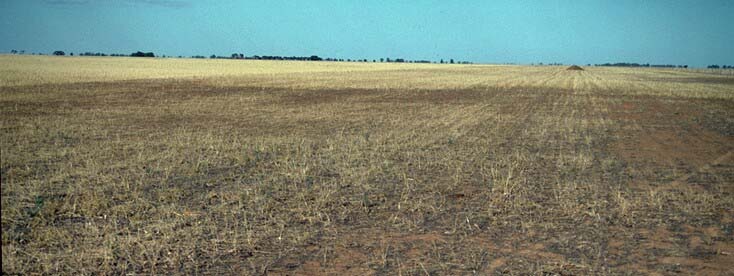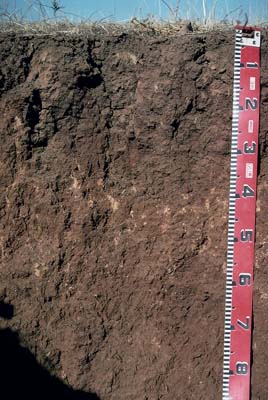LP55
| Property: LP55 Wanurp | Group: Pine Grove Farm Advance |
| Australian Soil Classification: Episodic-Epicalcareous, Epipedal, Red VERTOSOL | Northcote Factual Key: Ug 5.3 |
| Great Soil Group: brown clay | Geology: Quaternary (Shepparton Formation) alluvial and aeolian deposits. |
| General Landscape Description: Old alluvial plain (slightly rising) which originally supported "plains grass" (Stipa) as well as occasional River Red Gum (Eucalyptus camaldulensis), Black Box (E. largiflorens) and Grey Box (E. microcarpa). | |
 LP55 Landscape |
Soil Profile Morphology
Surface Soil
| A1 | 0-10 cm | Brown (7.5YR4/4); light medium clay; surface flake present as well as 3-4 cm wide surface cracks which extend into the upper B horizon; moderate fine to medium polyhedral structure; firm consistence dry; pH 7.9; clear change to: |  LP55 Profile |
| Subsoil | |||
| B21 | 10-35 cm | Reddish brown (5YR4/4); medium heavy clay; moderate coarse blocky, parting to strong fine to medium polyhedral structure; strong consistence dry; pH 8.6; clear and wavy change to: | |
| B22k | 35-50 cm | Yellowish red (5YR5/6); medium clay; strong medium polyhedral structure; firm consistence dry; contains a common (10%) amount of mainly fine-earth carbonates and very few (2%) gypsum segregations; pH 8.2; clear and wavy change to: | |
| B23 | 50-80 cm | Strong brown (7.5YR5/6); medium clay; strong medium polyhedral structure; very firm consistence moist; contains a common (10-15%) amount of gypsum segregations in the 50-60 cm zone; pH 8.3; diffuse change to: | |
| B24 | 80 cm+ | Strong brown (7.5YR5/6); light medium clay with small slickensides; very firm consistence moist; contains very few (2%) fine-earth carbonates; pH 8.6. | |
| NOTE: This soil corresponds with the Restdown Clay soil ("puff profile") of Skene and Harford (1964). | |||
Key Profile Features
- Clay texture throughout the profile.
- Surface and subsoil cracking.
Key Profile Characteristics
pH | Salinity Rating | |||
Surface (A1 horizon) | slightly alkaline | low | sodic | slight1 |
Subsoil (B21 horizon) | strongly alkaline | low | strongly sodic | strong |
Deeper subsoil (at 1 m) | strongly alkaline | high-very high | strongly sodic | none2 |
| 1 Strong dispersion after remoulding. 2 Lack of dispersion due to high level of soluble salts. | ||||
 |
Horizon | Horizon Depth | pH (water) | EC 1:5 | NaCl | Exchangeable Cations | |||
Ca | Mg | K | Na | |||||
meq/100g | ||||||||
A1 | 0-10 | 7.9 | 0.15 | 10 | 5.3 | 1.5 | 1.6 | |
B21 | 10-35 | 8.6 | 0.25 | 10 | 10 | 1.4 | 3.7 | |
B22k | 35-50 | 8.2 | 2.64 | 10 | 10 | 1.2 | 7.2 | |
B23 | 50-80 | 8.3 | 2.62 | 6.6 | 15 | 1.3 | 10 | |
B24 | 80+ | 8.6 | 2.17 | 6.1 | 14 | 1.2 | 10 | |
Horizon | Horizon Depth | Ex Al mg/kg | Ex Ac meq/100g | Field pF2.5 | Wilting Point pF4.2 | Coarse Sand (0.2-2.0mm) | Fine Sand (0.02-0.2mm) | Silt (0.002-0.02mm) | Clay (<0.002mm) |
A1 | 0-10 | 30.8 | 18.6 | 4 | 27 | 20 | 49 | ||
B21 | 10-35 | 4.5 | 27.5 | 2 | 16 | 15 | 66 | ||
B22k | 35-50 | 40.3 | 25.4 | ||||||
B23 | 50-80 | ||||||||
B24 | 80+ |
Management Considerations:
- In general, management strategies for all soils should aim to increase organic matter levels in the surface soil; minimise the degradation of soil aggregates and porosity; promote the development of stable biopores; improve the calcium status of the ion exchange complex (particularly when sodium is a significant part – i.e. sodic), and break up any hardpans. Less frequent tillage; using less aggressive implements, and working the soil at optimum moisture conditions can all assist in maintaining soil aggregation and porosity as well as reducing the breakdown of organic matter. Practices such as residue retention, minimum tillage and including pasture rotations could be utilised if cropping takes place in order to build up organic matter, reduce erosion risk and increase fertility.
- Plant available water capacity (PAWC) is estimated to be low (estimated at 75 mm) for this profile - based on the laboratory data available. PAWC is limited by the strongly sodic subsoil and the high salinity (at 35 cm depth).
Surface (A) Horizons
- When the soil is dry, heavy rains will move down soil cracks. This rapid recharge can be valuable for the survival of plants near wilting. When wet, the soil will swell and further infiltration of water will be relatively slow.
- Tillage of cracking clay soils should be avoided if the soil is wet (i.e. wetter than the plastic limit). At such moisture conditions, tillage or excessive trafficking or overstocking could result in structural damage (e.g. compaction, smearing) occurring. Ideally, tillage and trafficking should take place on cracking clay soils when the soil is drier than the plastic limit, down to at least the tillage depth.
- The surface soil is sodic and will disperse strongly after remoulding. Excessive cultivation or over stocking of the soil in a wet condition is likely to cause dispersion and may result in the development of surface crusting. Gypsum is usually an effective ameliorant on such soils.
Subsoil (B) Horizons
- The coarsely structured subsoil is strongly sodic and disperses in water. This is likely to result in water and root movement being restricted.
- The subsoil is strongly alkaline which indicates that some nutrients (e.g. phosphorus, iron, manganese and zinc) may be poorly available to plants.
- The salinity rating becomes medium from 35 cm depth in the profile and may restrict the growth of salt sensitive species.
Comments from Landholder
- Best cropping soil on property.
- Gilgai microrelief (i.e. “crabholey country") existed in the original state.
- Gypsum has not been used.


